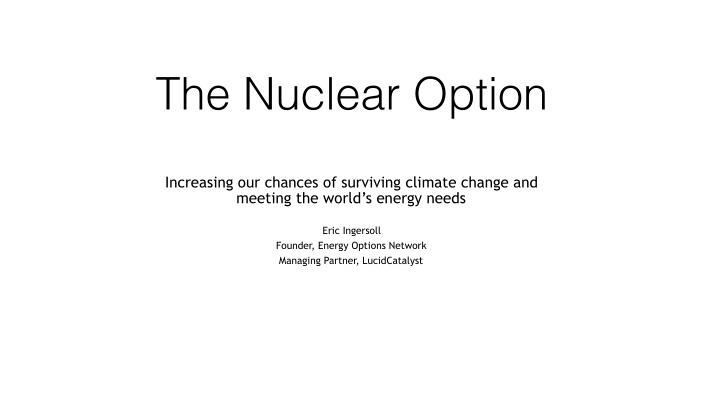



The Nuclear Option Increasing our chances of surviving climate change and meeting the world’s energy needs Eric Ingersoll Founder, Energy Options Network Managing Partner, LucidCatalyst
We are appear to be aiming for 5 o C 2
2 Degrees: In our dreams! 3 We are not on any of these paths Implications: • The risk of failure to decarbonize looks unacceptably high • We need to radically improve the chances of success • Re-examination of our energy technology preferences and risk prioritization is necessary Assumptions: • Air capture is needed for 50% of required negative emissions • Capture, compression and disposal requires ~250kWh/tonne • 10Gt CO2 /yr would require over 300 GW of baseload nuclear plants. Delaying significant emissions reductions increases required negative emissions
But wait—countries with predominantly nuclear electricity generation have already achieved very low levels of carbon intensity Carbon Intensity of Electricity (1990-2014) Chart Source: Clean Air Task Force, from International Energy Agency 4 data
…and they achieved it very quickly Source: EFH European Climate Leadership Report 2017, page 61
Maybe the most dangerous nuclear plant— is the one that isn’t built
But nuclear is too expensive—or is it? 7 30 Recently Completed Plants +2.0 +1.5 +1.0 Average Score +0.5 0.0 -0.5 -1.0 -1.5 -2.0 $1,500 /kW $3,500 /kW $5,500 /kW $7,500 /kW $9,500 /kW $11,500 /kW $13,500 /kW Source: https://www.eti.co.uk/library/the-eti-nuclear-cost-drivers-project-summary-report
8
Learnings from Sizewell B to Sizewell C 9 Cost Reduction Trajectory at Sizewell B and Nuclear Electric’s proposal for Sizewell C $18,000 /kW 30% reduction in overnight costs from $13,500 /kW Sizewell B to Nuclear Electric’s proposal for Sizewell C (single reactor) $9,000 /kW Savings based on contractually-bound estimates $4,500 /kW ~20 month improvement in construction schedule $0 /kW Sizewell B NE Sizewell C NE Sizewell C (Single Reactor) (Twin Reactors) Nuclear Steam Supply System Civil Other mechanical Turbines Control & instrumentation Electrical Construct and commission So fu ware Nuclear Steam Supply System Civil Other mechanical Turbines Control & instrumentation Electrical Construct and commission So fu ware
Barakah, Abu Dhabi 5,400 MW (4 x 1,400MW PWR) 10
Barakah (UAE): benefits of a multi-unit program 11 Extrapolation of Cost Reduction at Barakah Units 1 – 4 ($20.4B) • A comprehensive “lessons learned” study informed RfP and bidding process • Owner-led process that encouraged/imposed best practices in key aspects of project delivery • Commitment to 4-unit purchase • Same contractors and suppliers (building on successful deliveries in Korea) • Vendor allowed to optimize process/ sequence, build continuously, maintain skills and experience • 40% reduction in labor costs from unit 1 to unit 2 • No demobilization between units (moving people from unit to unit without lag)
12 Is it possible to organize significant cost reduction in a large industry?
13
UK Offshore Wind (50% price drop over 2 years*) 14 • Gov’t-supported “Offshore Renewables Catapult” funds R&D projects aimed at cost reduction through innovation and de-risking technology to lower financings costs • Relentless focus on cost reduction innovations by developers Offshore Wind Cost of Energy Offshore Wind Cost of Energy 240 60 UK’s Offshore Renewable Catapult Increase in Regional energy strategies, 220 societal engagement in decarbonisation, etc. 200 50 • Funded >150 180 collaborative R&D projects Cost of Electricity Cost of Energy, £/MWh 160 40 (Upper) Installed, GW 140 • Tests, demonstrates, 120 30 de-risks, and validates latest technologies Central gov. role in supporting regular PPAs signed build of new power plants, 100 decarbonisation, etc. Cost of Electricity 80 in 2017 20 • Partnerships with 52 academic institutions (Lower) 60 40 10 20 0 0 2010 2015 2020 2025 2030 2035 2040 2045 2050 * The CFDs were half the price of contracts awarded in the last UK offshore wind tender in February 2015.
The UK took a very comprehensive approach 15 • Multiple projects • All areas of cost • Careful monitoring • Clear incentives • Auction model • Would a similar approach work for nuclear?
16 Cost reduction is critical to climate/development success What if we engaged with the nuclear industry as constructively and as persistently as we have with wind and solar? Maybe the nuclear industry we have isn’t the one we need to help solve climate? What if we applied successful renewables policies—to nuclear?
Recommend
More recommend